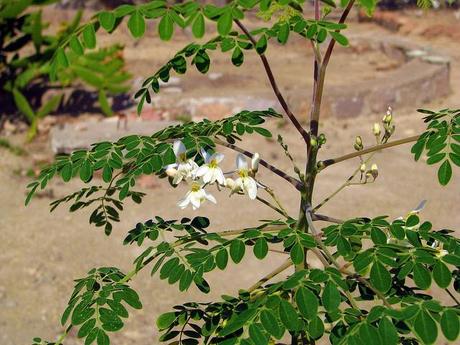
Photo by Linda De Volder
Recently my hubby involves in organic farming in a Hermitage. A friend introduces moringa plant to him. In Mandarin it is called 辣木树. It is an edible tropical tree where its young seed pods and leaves are used as vegetable. According to his friend local not knowing its health benefits and of course not knowing how to consume. In tropical climate like Malaysia this plant can grow freely almost every road side, front or back yard of your house. After internet searching this is what I found.Moringa oleifera is commonly known as names below:
1. Moringa
2. Drumstick tree (from the appearance of the long, slender, triangular seed-pods)
3. Horseradish tree (from the taste of the roots, which resembles horseradish)
4. Ben oil tree or benzoil tree (from the oil which is derived from the seeds)
Many parts of the moringa are edible. Regional uses of the moringa as food vary widely, and include:
1. The immature seed pods, called "drumsticks", popular in Asia and Africa. It is commonly used in India cuisine.
2. Leaves, particularly in the Cambodia, Philippines, South India, Sri Lanka and Africa.
3. Mature seeds
Oil pressed from the mature seeds
4. Roots, bark, sap
Use as traditional medicine in several countries. It is advised people NOT TO EAT the root of the Moringa Tree, because the root and the root bark contains some powerful toxins. In Jamaica, the sap is used for a blue dye.
5. Flowers
Some said taste like mushrooms when cookedMoringa leaves, from the Moringa tree, are a welcome addition to any diet, whether in its fresh state, or dried and ground into powder. According to Wikipedia moringa leaves are the most nutritious part of the plant. The leaves have traditional medical values as shown below.

Photo from Moringa Resources
According to Miracletrees.org eating 100 grams fresh Moringa oleifera tree leaves can provide as much protein as an egg, as much calcium as a big glass of milk, as much iron as a 200 grams beef steak, as much vitamin A as a carrot and as much vitamin C as an orange.

Picture from MiracleTrees.org
Looking at the rich nutrients in moringa plant made me feel like growing own moringa tree! Too bad I have no own backyard :D Raw Moringa leaves, have a slight pungent flavor reminiscent of watercress or radish. When cooked, the pungent flavor goes away, and Moringa tastes like spinach (some said). It only takes a few minutes to wilt and turn an intense green. It tastes great just with a simple seasoning butter, garlic, and salt.According to my hubby's friend local treats moringa leaves like manicai (cekur manis). They usually cook in egg soup and frying with eggs. He gave us a big bag of moringa leaves and hopping more recipes are created with these miracle moringa leaves. Cooking challenge with moringa leaves accepted!
I have tried making several dishes with the moringa leaves and going to share in coming posts. I hope more readers aware of this miracle plant. Subsequently use moringa leaves as one of fresh vegetable source in their family meals.